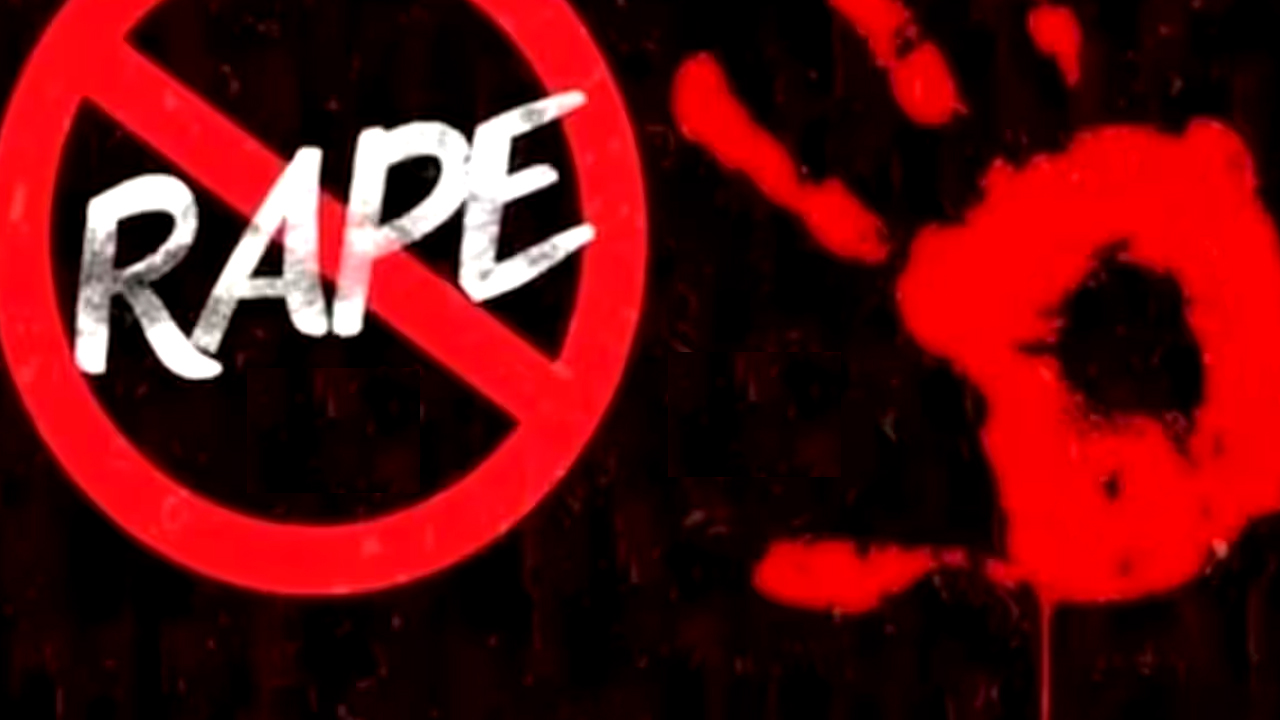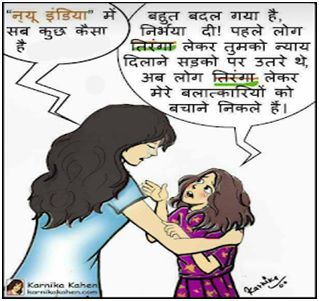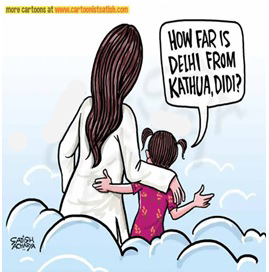In India’s recent history, the months of December and January would be marked forever with black ink. On December 16, 2012, a 22-year-old physiotherapy intern, dubbed “Nirbhaya” by the Indian media was gang-raped inside a bus she boarded in the national capital, Delhi, along with a male friend. In January 2018, an eight year old from Kathua district in the-then Jammu and Kashmir region was abducted, gang-raped and murdered. Eventually known as Kathua rape case, the incident did not garner as widespread a reaction as the Delhi rape case. One wonders, if six years down the road, one even remembers the Kathua rape case victim, writes Samyuktha Kannan.
December of 2012 in India saw the emergence of a new kind of influential movement for women’s rights. Following the gang rape of Nirbhaya, the streets of India rose in anger and frustration at the rampant structural, sexual and physical violence against women. The reaction that the incident warranted — protests and gatherings of hitherto unforeseen magnitude and significant changes taking place in the legal and political spheres — seemed to imply that the years of women’s movement in India have at last reached a point where there would be a permanent and systemic change in all spheres of life.
Eleven years down the road, December of 2023 saw Olympic wrestler Sakshi Malik announcing her retirement in protest against the election of a loyalist of the alleged sexual harasser, BJP MP Brij Bhushan Singh. The first half of 2023 saw Indian wrestlers protesting for the investigation into the alleged sexual harassment of their female colleagues, including a minor. Despite the serious allegations, Brij Bhushan Singh is still roaming free. 2023 also saw the horrific video of two women being sexually abused and paraded naked in the Northeastern state of Manipur. This is in addition to the hundreds of sexual violence cases that have gone and are going unnoticed and forgotten as we write and read this. Yet, unlike in the winter of 2012, there hasn’t been any popular outrage. Save and except a few protests and marches and dharnas here and there, as a society, we have stayed more or less silent.
How it is that systemic violence against women parasitically thrives in this society that brazenly boasts of being ‘forward’, ‘modern’ and/or ‘advanced’? Is it really that we are neck deep in what some people have started calling, with unapologetic casualness, “India’s Rape Problem”? Are we all complicit, in one way or the other, within the overwhelming silence that envelops us all right now? What can explain the selective amnesia that some instances of violence against women seem to be undergoing when contrasted with others?
A few years ago an image circulated on social media. The image captured the eight-year-old girl from the Bakerwal community in Kashmir, who was abducted, raped and killed, meeting Nirbhaya after her tragic death. Their conversation inevitably revolves around the issues of sexual violence and the ways in which the former has come to be implicated within popular national symbols and nationalisms. In the depicted conversation, Nirbhaya enquires about the state of the ‘New India,’ to which the Kathua rape case victim responds, ‘Bahut badal gaya hai, Nirbhaya di, pehele log thiranga lekar tumko nyaya dilane sadko par uthre the, ab log tiranga lekar mere balatkariyon ko bachane nikle hai.’ (‘A lot has changed, Nirbhaya. Previously, people used to take the national flag to fight for justice for you on the streets. Now, people take the national flag to protect my rapists.’)
This statement not only reveals the evolving social dynamics where the ruling elite manipulates nationalist symbols to preserve their power and privilege, but also sheds light on how the use of such symbols further render invisible girls and women who belong to marginalized communities, and are therefore, often doubly or triply oppressed. The complicated story that unfolds after the Kathua rape case victim’s death thus becomes yet another effort by the state to disregard spaces that are considered marginalized. One is, then, also prompted to ask the role that the state as an institution plays in the sexual violation of girls and women like the Kathua rape case victim, who unlike Nirbhaya, do not represent an upper-caste, Brahmanical femininity that appeals to the majoritarian mindset of the nation.
The Kathua rape case victim and Nirbhaya: A Comparison
In the Kathua rape case victim’s case, sexual violence was rooted in the alleged larger motivation of the perpetrators to displace the Bakarwal community, reflecting a broader struggle for power and resources in the region. One also needs to remember that in Kashmir (like in Northeast and other conflict areas) — the place where the minor girl came from — rape and sexual violence have often been used as weapons of state control. That she belonged to a Muslim nomadic community in a conflict-torn region also became a crucial issue in how her rape came to be interpreted in the mainstream. In the aftermath of her rape, some groups sought to defend the accused and diminish the gravity of the crime, employing religious and communal rhetoric to undermine calls for justice and accountability.
One cannot help notice, how popular narratives that surrounded these two instances of the same crime, were starkly different. While Nirbhaya’s case gained widespread attention and garnered conversations about women’s safety and gender violence in India, the majority of the little attention that the Kathua rape case victim’s case got, could not go beyond broader communal and political implications behind the crime. The question of why such a different reaction to a crime, seemingly of the same nature, ceases to be just a moral one but becomes political.
In the documentary ‘India’s Daughter,’ ‘Nirbhaya,’ as the raped women victim from Delhi was dubbed by the media, was represented as a middle-class, family-oriented woman who prioritised cultural and religious values and was primarily a Hindu who upheld the social fabric of her community. In short, she embodied everything that made her into an ideal “Bharatiya Nari,” with whom millions of other aspiring Bharatiya Naris could identify, and whose rape and eventual death appeared to be an ultimate assault on the body of the nation itself. The absence of these factors in the Kathua rape victim’s case means she cannot be accommodated into the category of “Bharatiya Nari,” and therefore, her violation cannot also acquire the discourse it deserves. In other words, the girl victim from Kathua could not be considered as ‘India’s Daughter.’ Coming from a nomadic community in Kashmir, however, the minor girl would not and could not provide such a story which would appeal to the popular sentiments of the Indian middle-classes.
The Nirbhaya and Kathua rape victim’s cases, therefore, both involve heinous crimes against women, but the ways in which they inspired very different kinds of public reaction, also speak of different forms of ideological violence, that are ultimately tied to different socio-political contexts.
The Nirbhaya case garnered extensive media coverage, igniting widespread protests and calls for justice. Despite the equally heinous nature of the crime, the other case received less media attention and failed to generate the same level of public outrage and activism witnessed in the Nirbhaya case. This discrepancy can be attributed, in part, to the fact that in Kathua, the victim, was a poor Muslim girl from a marginalized community, her case did not attract the advocacy of mainstream feminist groups from the Indian “mainland” in the same way, and the fact that her rapists were Hindu men, also enabled a communal colouring of the event, where the story of her violation was ultimately lost.
The Kathua rape victim’s case brought attention to the complex intersections of gender, caste, religion, and politics in India. It raised critical questions about the role of both the state and society in perpetuating violence against marginalized groups, emphasizing the need for a comprehensive understanding of the various factors contributing to such atrocities. The Kathua rape case also showed, sexual violence can often be used as an important weapon in keeping the said communities in control, thus transforming women into symbols of the communities to which they belong.
In Nirbhaya’s case, since almost the entire narrative surrounding the cases concentrated on the individual perpetrators and victims, systemic shortcomings on the part of the state and long-term systemic violence were mostly overlooked. The Kathua rape victim’s identity as that of a Muslim child from Kashmir, meant that those structural factors could not be ignored. Consequently, even when the Indian netizens spoke up demanding “Justice” for her, structural factors were mostly ignored. The primary impulse, in those campaigns, often was to provide a homogenized narrative about sexual violence in India, and to place the Kathua rape victim as just another victim within that narrative. Also the long history of the use of sexual violence as a weapon of collective punishment in the region by the state institutions, were conveniently ignored in most of these digital campaigns.
What then can also be concluded; regional dynamics deeply influence political contexts and social narratives. For most members of the middle-classes who often constitute the most vocal section of the campaigns against state violence, it is difficult to imagine what it means to grow up in Kashmir as a little girl, belonging to a poor nomadic Muslim community. On the other hand, the story of a young woman from the national capital city of Delhi, visiting a mall with her friend during a weekend to watch a movie, comes across as an overtly familiar terrain. Consequently, the violation of the latter strikes home, leading to an overwhelming eruption of collective outrage. On the other hand, the former, unfamiliar and farther from the nation’s middle-class political and socio-cultural imagination, is always kept at an arm’s length. It is then also this dichotomy between Delhi and Kashmir that informs the narrative of both the cases. With the recurrent conflicts and the constant ‘state of exception’ that Kashmir seems to be in, we can see how the narrative following the Kathua rape case becomes yet another attempt by the state to overlook ‘marginalised’ spaces. However, homogenizing as the campaign for the Kathua girl’s justice has been in India, the contemporary digital activist art often recorded such moments, as is obvious in the visual enclosed below:
Would the minor girl from Kathua have ever met Nirbhaya when both were alive? Chances are rare. What would they have talked about if they did? One doesn’t know if any “real” conversations would ever have been possible between them. Yet, what this visual points out, extremely poignant as it is, in their deaths they come together. And, in such coming together, the minor girl from Kathua poses to Nirbhaya certain difficult questions: “What if you were from Manipur or Nagaland? Would you then still be considered as ‘India’s Daughter’?”
There is a horror in such an imagination. The answer to such questions might reveal the myriad dishonesties of the world today, lingual, political and countless others. But even if one does acknowledge the validity of these questions, the fact remains that no woman should have to find oneself in a place where they need to pose such questions to each other. Indeed, one does not know how many more brutal deaths of countless women our society needs, for some honesty to permeate our political discourse.
Indeed, both these deaths come to us as a reminder of other violations and the countless other victims of rape whose experiences, the system made sure, were built around unfair contingencies. While in their lives these women had no ways of knowing one another, in their deaths, they came to form a community — however tenuous that community might be.
So, the wrestlers’ protest of 2023, Sakshi Malik announcing her retirement, BJP MP Brij Bhushan Singh still roaming free, the two women who were paraded naked in Manipur, are not isolated incidents, but malignant symptoms of a diseased continuum. A diseased continuum that we refuse to see as a whole, instead, picking and choosing names from this long list, according to our locational and ideological convenience. It’s time we stopped calling it “India’s Rape problem”. It’s us. India is us. We’re the problem. The ones with the entitlement to choose who should be seen and who doesn’t.
(Samyuktha Kannan is a student of O. P. Jindal Global University)
Editorial Note:
*The identity and names of the victims has not been disclosed because section 228A of the IPC prohibits anyone from making identity of victim of such offence known. Section 228A was inserted in the Indian Penal Code by the Criminal Law Amendment Act, 1983 to prevent social victimization or ostracism of the victim of a sexual offence.
*In the ‘Delhi Gang Rape Case’ the parents of the deceased victim openly came forward and disclosed the name of the victim. They remarked that “Our daughter was not at fault. If anyone should hide their identities, it should be the perpetrators.”



